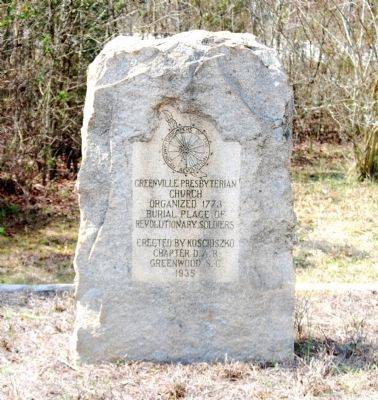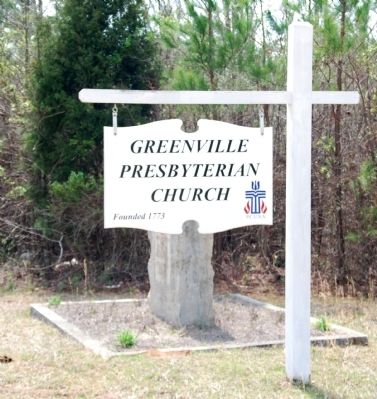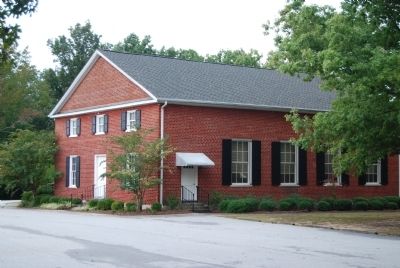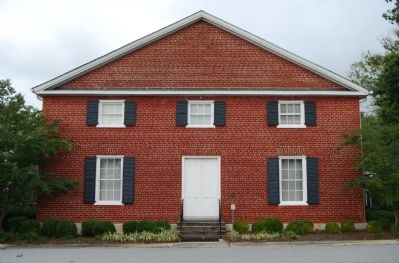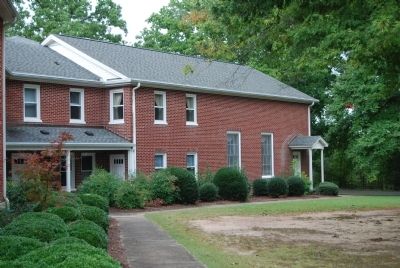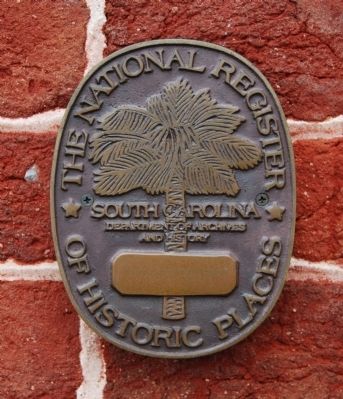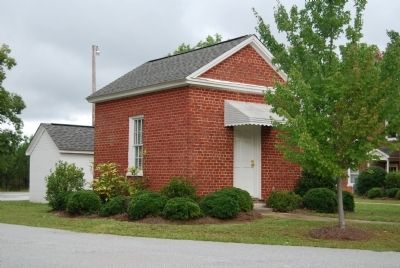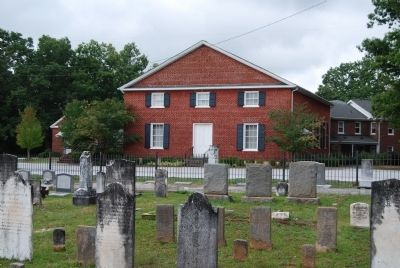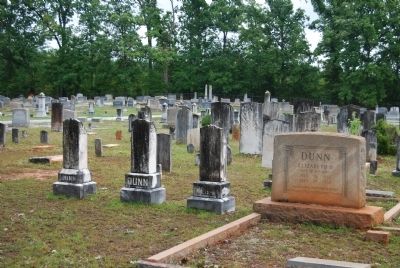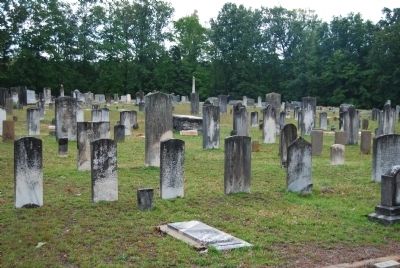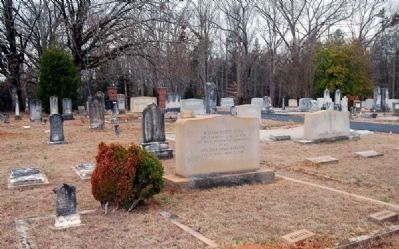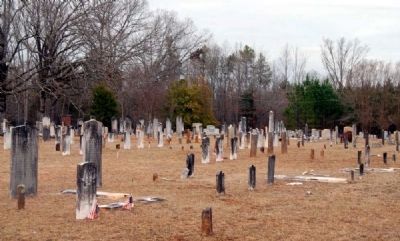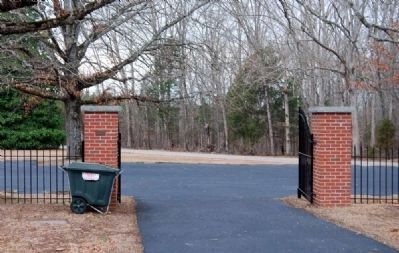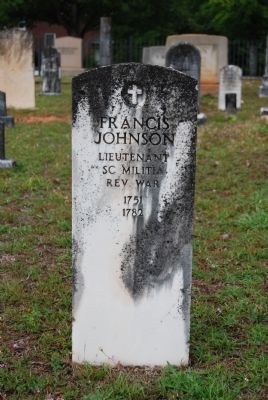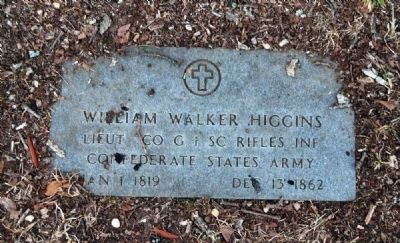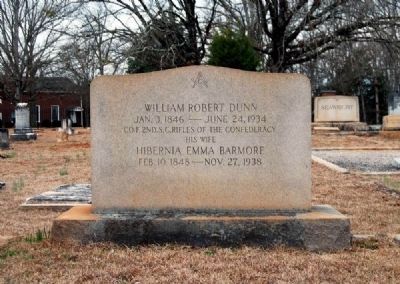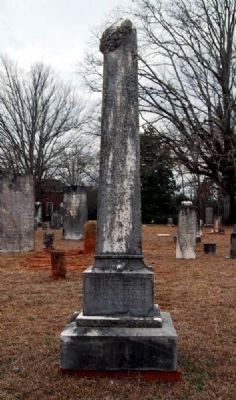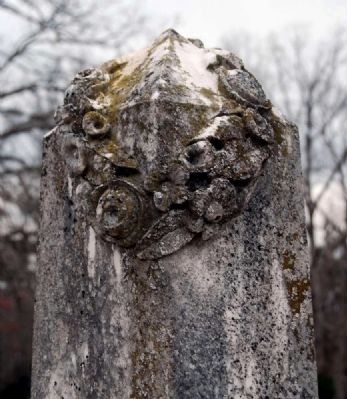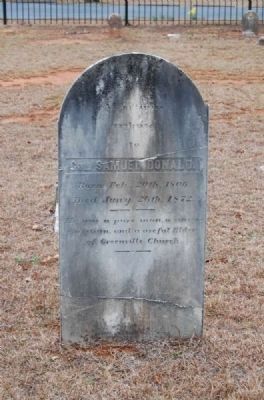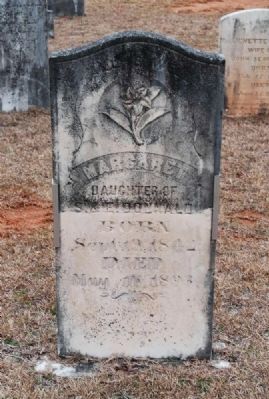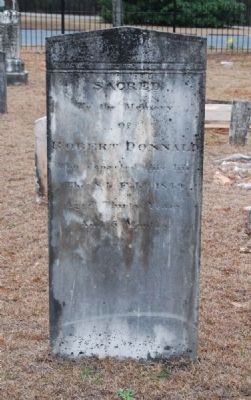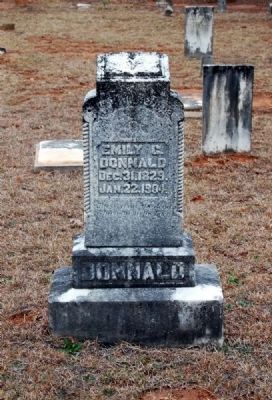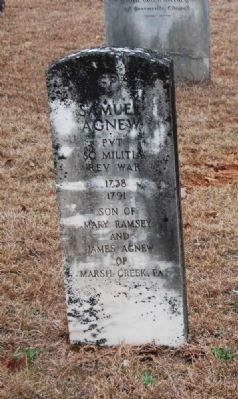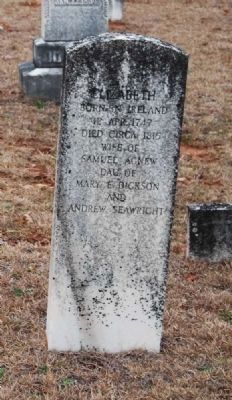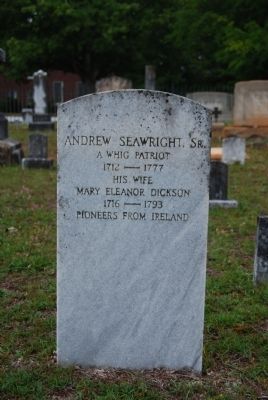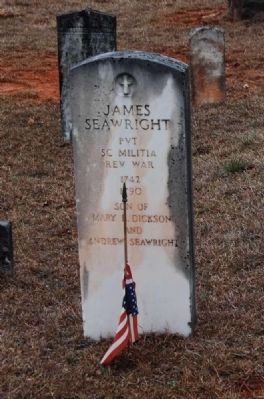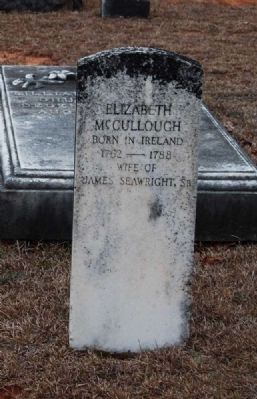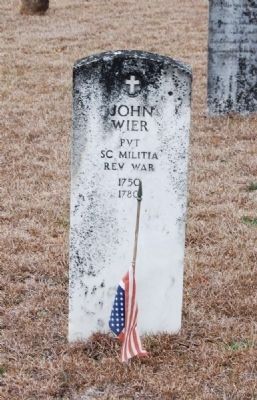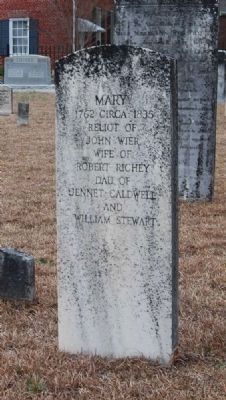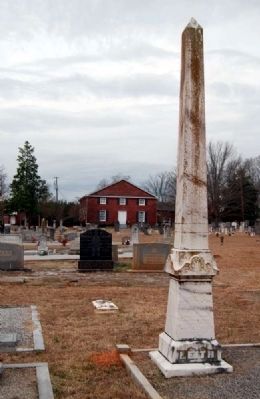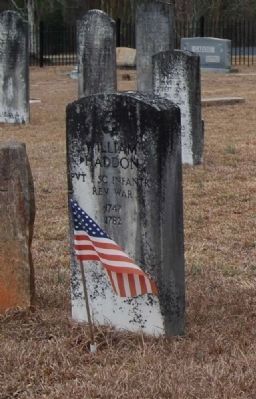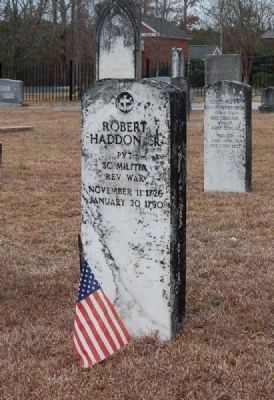Donalds in Greenwood County, South Carolina — The American South (South Atlantic)
Greenville Presbyterian Church
American Presbyterian and Reformed Historical Site
Burial Place of
Revolutionary Soldiers
Erected 1935 by Kosciuszko Chapter, D.A.R. of Greenwood, S.C. (Marker Number 377.)
Topics and series. This historical marker is listed in these topic lists: Cemeteries & Burial Sites • Churches & Religion • War, US Revolutionary. In addition, it is included in the American Presbyterian and Reformed Historic Sites, and the Daughters of the American Revolution series lists. A significant historical year for this entry is 1773.
Location. 34° 21.05′ N, 82° 18.117′ W. Marker is in Donalds, South Carolina, in Greenwood County. Marker is at the intersection of Old Shoals Junction Road (U.S. 178) and Bell Road, on the right when traveling south on Old Shoals Junction Road. Touch for map. Marker is at or near this postal address: 205 Greenville Church Road, Donalds SC 29638, United States of America. Touch for directions.
Other nearby markers. At least 8 other markers are within 5 miles of this marker, measured as the crow flies. The Donalds Grange No. 497 (approx. 3.1 miles away); Templeton-Drake Cabin ca. 1764 (approx. 3.1 miles away); Boonesborough Township (1763) (approx. 3.1 miles away); Ware Shoals Veterans Memorial (approx. 4.6 miles away); Benjamin DeWitt Riegel (approx. 4.6 miles away); Ware Shoals School / Ware Shoals High School (approx. 4.6 miles away); Ware Shoals High School Veterans Memorial (approx. 4.6 miles away); Good Hope Baptist Church (approx. 4.7 miles away). Touch for a list and map of all markers in Donalds.
Regarding Greenville Presbyterian Church. Greenville Presbyterian Church was listed in the National Register of Historic Places in 1998. This church is also one of 445 American Presbyterian and Reformed Historical Sites registered between 1973 and 2003 by the Presbyterian Historical Society (PHS), headquartered in Philadelphia. Approved sites received a metal plaque featuring John Calvin’s seal and the site’s registry number (PHS marker location in front of church building).
The following text is taken from the Presbyterian Historical Society website:
Greenville Presbyterian Church has been a site of Presbyterian worship since 1773. Rev. John Harris, the first stated minister of Greenville Presbyterian Church and a native of Wales, was a staunch supporter of American independence. Supposedly, he carried his rifle wherever he went, even into the pulpit, in case British troops disturbed his service. In 1852, the congregation dedicated the current red-brick building. Builders used clay dug from the church’s property to make the bricks for this edifice. An educational building was added in 1952, and in 1953, the Sears Roebuck Foundation and Emory University awarded Greenville Presbyterian the “Rural Church of the Year Award.” The church became fully air-conditioned in 1979.
Also see . . .
1. Greenville Presbyterian Church. Regular religious services and social gatherings have been conducted on this site since 1773. (Submitted on September 27, 2008, by Brian Scott of Anderson, South Carolina.)
2. Find a Grave: Greenville Presbyterian Church Cemetery. Includes photos of 192 tombstones. (Submitted on February 19, 2010, by Brian Scott of Anderson, South Carolina.)
Additional commentary.
1. Greenville Presbyterian Church - National Register Nomination Form.(1998)
Greenville Presbyterian Church is located in a rural setting in Greenwood County, on state road 54 (Greenville Church Road), approximately .25 miles west of US Highway 178, in the vicinity of Shoals Junction and Donalds. Regular religious services and social gatherings have been conducted on this site since 1773. The church building itself has also been in continuous use since its construction in 1852, providing a place for worship and other religious and social activities for its congregation and community. Also present on the property and contributing to the overall historic character of Greenville Presbyterian Church are the small brick Session House, constructed to match in detail the sanctuary, a large historic cemetery, and a natural spring.
The church building, finished in a straightforward and unadorned "meeting house" form, however, basically Greek or Classical Revival in style, is rectangular in shape and measures 64' 10" x 46' 9". It is constructed of brick handmade on the site. It features solid brick walls sixteen inches thick. The foundation, also of brick construction, is approximately eight inches thicker than the walls. A Portland cement stucco was applied to the foundation during the early twentieth century, and is in need of repair or removal. The bricks are laid in a five-to-one common bond with a dirt/lime-based mortar. Since original construction the exterior brick walls have been repointed with a sand/lime-based mortar. The exterior walls are twenty feet high. The roof features boxed cornices and pedimented brick gables. The roof structure was designed to be "a Self supporting one Plan & Size of timbers at the discretion of the undertaker who is to be responsible for its Strength & adaptation to the building for which it is intended." It is interesting, however, that the architect, an unknown Mr. Johnson who specified all dimensions and materials for the building, made this allowance but had stipulated
previously that the roof was to have "Seven pair of Principle Rafters with one King [actually a straining beam rather than a true king post] & two Queen posts to each together with the customary Braces. Sise of timbers wall Plates 4 by 12 in Crop Girders 6 by loin Principle Rafters 6 by 8 Purlines & Truss Braces 4 by 6 in King & Queen Posts 6 by l2 in Crown Board 2 by Sin Small Rafters 2 1/2 by 5."
The principal facade (east gable end) is three-bays wide and consists of a central entrance with a double-leaf paneled door, approached by four stone or masonry steps with iron handrail, flanked by two six-aver-six, double-hung sash windows. On the upper or gallery level are three six-light windows. On either side elevation and near the front are single-leaf entrances to the church's narthex, and four large six-over-six, double-hung sash windows, and on the west (rear) elevation are two six-over-six, double-hung sash. Because of a rear brick addition, the northernmost window is no longer exposed to view from the exterior. All windows and doors feature jack arches and louvered wooden shutters, except for those on the southern and western exposure.
The narthex is twelve feet wide with an eight-foot ceiling spanning the entire width of the building on the east end. Immediately above the narthex is the balcony, originally constructed with a three tier elevated floor. The three exterior doors open into this narthex and there are two doors opening from the narthex into the sanctuary. Just inside the narthex, on the north and south entrances, are stairs that lead to the balcony, originally made for and used as a slave gallery. The east facade double door is original with a hand-made hook-and-eye latch with a wooden lever to secure the hook into the eye. The narthex now contains a historical display case containing some artifacts and historical material. Among these are a handwritten sermon by the Reverend John Cunningham Williams as preached here in 1867, a diary kept by the Reverend William F. Pearson when he served in the Civil War as a chaplain for the Second Regiment, South Carolina Volunteers, a retired pulpit bible, as well as historical photographs. There is also a refurbished eighteenth century sofa presented to the church by a former member.
The sanctuary measures 52' x 44' with a ceiling height of seventeen feet. The ceilings of the narthex and sanctuary are constructed of hand planed tongue and groove pine boards of various widths, and they remain in excellent condition. The plaster walls, applied directly to the brick, remain in excellent condition, and are unadorned except for six stone tablets along the west wall, either behind or near the pulpit, that commemorate the service of former pastors, one stone tablet to the Scotch-Irish founders of the church, and one to the church members who fought and died in the Confederate army. The window sashes are of heart pine glazed with clear glass containing some imperfections giving a wavy appearance. The trim for the doors and windows is also made of hand-planed pine. Pulpit furniture, purchased in 1900, remains in use today.
A brick educational building was added to the rear of the building in 1952; however, it is connected by a narrow building which is recessed sufficiently from the side walls of the historic sanctuary, is lower in height and profile, and therefore does not detract from or overwhelm the original structure.
The Session House is located forty-one feet to the south and parallel to the church and is of the same style and material as the church. It measures eighteen feet by fourteen feet with exterior walls measuring fourteen feet high and the ceiling ten feet in height. The Session House is thought to have been built before 1859 by James Seawright for the sum of $174.75.
A large cemetery, located immediately across the dirt road and in front of the church contains graves which date from the eighteenth century, the earliest being 1777. Identifiable graves number approximately 1,200. Numerous markers, some purchased from the government but many private, indicate service in the American Revolution and Civil War. Many markers
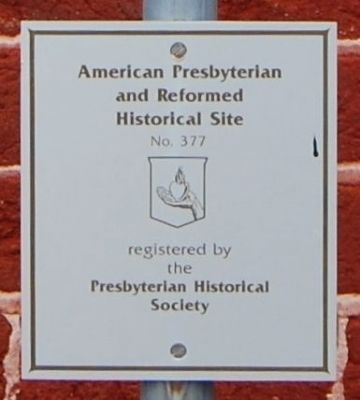
Photographed By Brian Scott, September 27, 2008
7. American Presbyterian and
Reformed Historical Site
Reformed Historical Site
Greenville Presbyterian Church is one of five churches in the Trinity District of the South Atlantic Synod. The others are Upper Long Cane Creek Presbyterian (Abbeville), Mount Olivet Presbyterian Church (Winnsboro), Ebenezer Associate Reformed Presbyterian Church (Winnsboro), and Little River Presbyterian Church (Kinards).
A natural spring is located some five hundred feet northwest of the church on church property. It is enclosed with cut granite stone, was used for drinking water as well as for baptisms, and remains in use today.
Significance
Greenville Presbyterian Church is significant for its broad impact on the history of the area known as Long Canes in what is now Greenwood County. The church, along with other Presbyterian churches in the Long Canes area, influenced the basic structure of society for Scots-Irish settlers in this part of South Carolina. The earliest history of Greenville Presbyterian Church is interwoven with that of the Scots-Irish pioneers who, in the 1760s, petitioned their Synod for ministers as they sought to establish and maintain a Presbyterian Church in the Long Canes area of the colony of South Carolina.
As early as 1765 the minutes of the Synod of New York and Philadelphia record a supplication from settlers in the Long Canes for ministers. In the l760s and 1770s, Presbyterian ministers, most from Pennsylvania, traveled to the Long Canes area of South Carolina and five churches emerged from their itinerant ministry. Among those churches was a congregation named Saluda. By 1783, definite boundaries were fixed between the several churches of the Long Canes area, as agreed by commissioners from each church. This agreement formally expressed the community's desire to make the area "Christian and, more particularly, a Presbyterian community."
Saluda church is believed to have been named so because many of its members resided near the Saluda River. When the church was chartered in 1787, Saluda changed its name to Greenville Presbyterian Church. The site for the church was located centrally in Boonesborough township which had been laid out in the 1760s for prospective Scots-Irish immigrants. The 1787 church was a log structure, but was replaced in 1804 with a wood-sided building.
In 1852 the present church building was constructed, consisting of a sanctuary, gallery, and narthex. The church was built from bricks made on the site some 400 yards southeast of the church. The new building housed a congregation that had slowly, but steadily, grown from just a small faithful few to 147 members in 1847. The new church building allowed congregational life to blossom in the last half of the nineteenth century as a church school was established at mid-century and a Presbyterian Women's organization was founded in 1895. The Greenville Presbyterian Church building was no longer new as the twentieth century arrived but it was adapted to new technologies. In 1925 Coleman gas lanterns were installed in the sanctuary only to be replaced by electric incandescent lights in 1938.
The date the cemetery at Greenville Presbyterian was established is unknown. The earliest mention of the cemetery in church records appears in 1888, but the earliest identifiable marker is from 1777 and there are at least twenty-seven soldiers from the American Revolution buried at Greenville.
— Submitted February 19, 2010, by Brian Scott of Anderson, South Carolina.
2. Unveil Markers Today at Graves of Heroes in Revolutionary War
by Jim Oliphant
Spartanburg Herald-Journal
June 15, 1952
It's quite an event when descendants from 26 states gather in a country churchyard to pay tribute to a handful of men who fought in America's first war.
That's what is happening today at historic Greenville Presbyterian Church at Shoals Junction near Donalds in Abbeville County.
Markers at the graves of 33 Revolutionary War heroes and their wives will be unveiled by their descendants.
Today is the 46th annual Wyatt reunion, 190th anniversary of the founding of Greenville Church and a day of honor for those who sleep in this picturesque cemetery.
More than 200 descendants live in Spartanburg County and countless others in the Piedmont section. More than 30 from this county will take part in the day's program.
A tableau-pageant of 400 persons, all of them descendants of the Revolutionary War soldiers, will be a highlight of the program. Of this number 240 will be children dressed in white, wearing three-ribbon sashes of red, white, and blue.
Chapters of the Daughters of the American Revolution throughout the state and adjacent areas in Georgia will be represented.
Philip Willkie of Rushville, Ind., son of Mrs. Wendell Willkie and the late Mr. Willkie, is expected to be principal speaker. Mr. Willkie has three Revolutionary ancestors buried here.
Another distinguished visitor for the day is expected to be Gov. Adlai Stephenson of Illinois who also has Revolutionary ancestors buried in the churchyard.
Gen. W.P. Shepard of Fort Jackson will pay tribute to the Revolutionary soldiers. Families will spread their picnic lunches in the nearby Roadside Park. About 2,000 are expected.
Greenville Church, sometimes called Greenvale, furnished 75 soldiers in the Revolution and 50 of them are buried here. At their graves shining white markers, official War Department ones, have been erected.
Though the Wyatt family first began the grave-marking project for 16 Revolutionary soldiers of their family, other allied families later joined them.
Leonardo Andrea of Columbia, chairman of arrangement for the day, said many Revolutionary relics will be on display and it is planned to raise money to furnish a memorial room in the new parish house which is being constructed at the church.
The Greenville Church was organized June 15, 1762 on the banks of Saluda River, moving later to the present site. It is deep in the tradition of the South and is known in many places.
When the late rev. J.M. Dallas, one of the pastors, wrote a history of the church, he told of how rigidly its members observed the Sabbath. He said that on Sunday there was no cooking and no visiting by neighbors and the Ten Commandments were kept by the entire congregation.
A monument to theScotch-Irish pioneers is among many memorials in the church.
Beside the Wyatt clan here are families holding reunions today at the church: Agnew, Haddon, Johnson, Purdy, Stewart, Wardlaw, Brownlee, Jarvis, Miller, Richey, Swain, Wilson, Rasor, LaBoon, Pharr, Seawright, Sharp, Smith, Weir, Webb and their descendants.
Here are Revolutionary soldiers and their wives whose memory will be honored:
Sam Agnew and Elizabeth Seawright
George Brownlee and Sarah Caldwell
Samuel Cross and Elizabeth Finley
James Dunn and Agnes Agnew
Robert Hadden Sr. and Jane Ross Lindsay
Robert Hadden Jr. and Jean Seawright
Francis Johnson and Margaret Seawright
Samuel Pharr and Elizabeth Bailey
Christian Rasor and Sarah Sims
James Richey Sr. and Margaret Caldwell
James Richey Kr., and Elizabeth Dunn
John Richey and Nancy Ann Brownlee
Robert Richey and Nancy Ann Brownlee
Robert Richey and Mary Stewart Wier
William Richey
Andrew Seawright and Mary Eleanor Dickson
James Seawright and Elizabeth McCullough
Edward Sharp and Eleanor
Moses Smith and Ann Cullom
Wyatt Smith and Elizabeth Sandord
William Stewart and Jennet Cladwell
John Swain, Mary Smith and Anna Mayne
Robert Swain Sr. and wife
John Wardlaw Sr., Elizabeth Coalter and Mary Liller
John Wardlaw and Jane Bowman
James Webb and Elizabeth Maxwell
Andrew Webb and Agnes
John Wier and Mary Stewart
George Wilson and Ann Richey
William Wyatt, Francis Newton and Elizabeth Snoe
Elisha Jarvis and Densilla Smith
Pierre LeBon (LaBonn) and Anne Gervais
William Millie and Margaret S. Johnson
The Rev. McGill is present pastor of Greenville Church.
Its windows look out across the old cemetery. Its tombstones are either shiny and white or aged and weather beaten, but few places hold so much significance in history.
— Submitted February 19, 2010, by Brian Scott of Anderson, South Carolina.
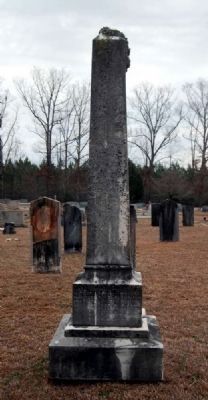
Photographed By Brian Scott, February 28, 2011
19. Andrew Dunn, M.D. Tombstone -
Reverse
Reverse
This Record of Mortality Repose
the Remains of a Devoted Husband
Affectionate Father, Skillful
Phisician [sic], Kind Heighbor
and Good Citizen.
-----
If life asteemed. In death lamented.
"His end was peace."
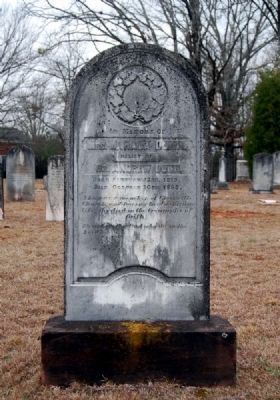
Photographed By Brian Scott, February 28, 2011
21. Mahala Dunn Tombstone
Mrs. Mahala Dunn
Relict of
Dr. Andrew Dunn
Born February 23rd, 1819
Died October 30th 1868
She was a member of Greenville
Church, and lived a Christian
life; she died in the triumphs of
faith.
Blessed are the dead who die in the
Lord.
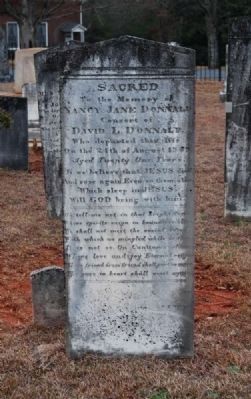
Photographed By Brian Scott, February 28, 2011
22. Nancy Jane Donnald Tombstone
Carved by W.T. White
Carved by W.T. White
to the Memory of
Nancy Jane Donnald
Consort of
David L. Donnald
who departed this life
on the 24th of August 1849
Aged Twenty One Years.
If we believe that Jesus died
and rose again, Even so them also
Which sleep in Jesus
Will God bring with him.
----------
Oh! tell me not in that bright land,
Where spirits reign in boundless bliss,
We shall not meet the social land.
With which we mingled while in this.
It is not so. On Canaan's shore,
Where love and joy Eternal reign.
Where friend from friend shall part no more.
The pure in heart shall meet again.
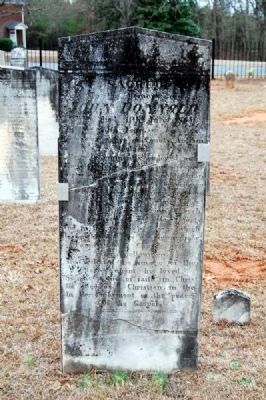
Photographed By Brian Scott, February 28, 2011
23. John Donnald Tombstone
Carved by W.T. White
Carved by W.T. White
to the Memory of
John Donnald
who died 11th July 1855
in the 54th Year of his age.
He was a native of County Antrim
Ireland
He was eminently endowed with
These ... respect
... in an
... religion
Jesus ... previous
To his ... Elder
Greenville Presbyterian Church
is ... and humble piety
And in the ... relations, which
He sustained his own immediate
Family, to the Church and
To his fellowman,
He reflected the image of the
Master whom he loved.
His was a life of faith in Christ.
He died as a Christian, in the
in the employment of the "peace"
of the Gospel
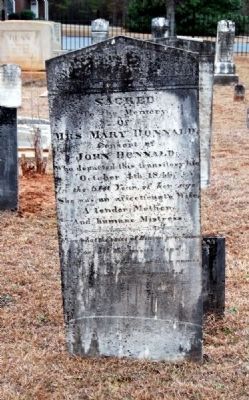
Photographed By Brian Scott, February 28, 2011
24. Mary Donnald Tombstone
Carved by W.T. White
Carved by W.T. White
to the Memory
Mrs. Mary Donnald
Consort of
John Donnald
who departed this transitory life
October 4th 1846
In the 61st Year of her age
She was an affectionate Wife,
a tender Mother,
and humane Mistress.
-----
Here what the Spirits of Heaven proclaims
For all the pious dead,
Sweet is the Saviour of their names
And soft their sleeping bed.
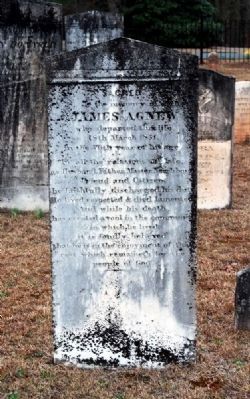
Photographed By Brian Scott, February 28, 2011
29. James Agnew Tombstone
to the Memory of
James Agnew
who departed this life
18th March 1851
in the 76th year of his age.
In all the relations of his life,
as Husband, Father, Master, Neighbor,
Friend and Citizen,
be faithfully discharged his duty.
He lived respected & died lamented.
And while his death
has created a void in the community
in which he lived
it is findly believed
that he is in the enjoyment of that
"rest which remaineth for the
people of God."
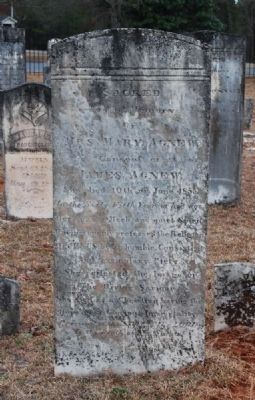
Photographed By Brian Scott, February 28, 2011
30. Mary Agnew Tombstone
to the Memory
of
Mrs. Mary Agnew
Consort of
James Agnew
She died 10th of June 1855
In the Sixty Fifth Year of Her Age
Hers was a Meek and quiet Spirit
Having openly professed the Religion
of Jesus by an humble, Consistent
and exemplary Piety.
She reflected the Image of
the Divine Savior.
She died as a Christian having the
Hope of a Glorious Immortality.
Precious in the Sight of the Lord
is the Death of his Saints.
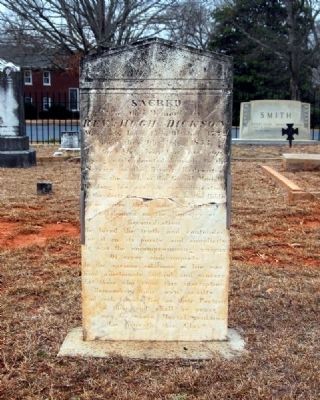
Photographed By Brian Scott, February 28, 2011
38. Rev. Hugh Dickson Tombstone
to the Memory of
Rev. Hugh Dickson
who was born 15th October 1772
Died the 9th July 1853.
In the 81st Year of his age.
Having early devoted himself to the
Service of the Divine Redeemer
and to the work of the Gospel Ministry
His long life was an exemplification
of the doctrines and truths of the Bible.
For more than half a Century
He labored in the Ministry of
Reconciliation.
He loved the truth and contended
for it in its purity and simplicity.
He was the uncompromising enemy
of error and impiety.
In the various relations of life was
kind, affectionate, faithful and sincere.
Let those who read this inscription
remember their own frailty
and seek Israel's God as their Portion
and then end shall be peace
As was his whose Mortal remains
lie beneath this Clay.
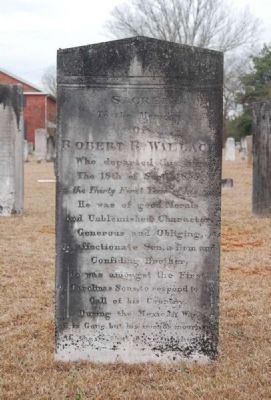
Photographed By Brian Scott, February 28, 2011
39. Robert R. Wallace Tombstone
to the Memory
who departed this life
the 18th of Sept 1855
In the Thirty First Years of his age
He was of good Morals
and Unblemished Character
Generous and Obliging
An affectionate Son, a firm and
Confiding Brother,
He was amongst the First
of Carolina's Sons to respond to the
Call of his Country
During the Mexican War.
He is Gone but his friends mourn.
Credits. This page was last revised on August 5, 2021. It was originally submitted on September 27, 2008, by Brian Scott of Anderson, South Carolina. This page has been viewed 5,169 times since then and 78 times this year. Last updated on August 17, 2018, by Douglass Halvorsen of Klamath Falls, Oregon. Photos: 1, 2, 3, 4, 5, 6, 7, 8, 9, 10, 11. submitted on September 27, 2008, by Brian Scott of Anderson, South Carolina. 12. submitted on March 4, 2011, by Brian Scott of Anderson, South Carolina. 13. submitted on March 5, 2011, by Brian Scott of Anderson, South Carolina. 14. submitted on March 4, 2011, by Brian Scott of Anderson, South Carolina. 15. submitted on September 27, 2008, by Brian Scott of Anderson, South Carolina. 16, 17, 18, 19, 20, 21, 22, 23, 24, 25, 26, 27, 28, 29, 30, 31, 32. submitted on March 4, 2011, by Brian Scott of Anderson, South Carolina. 33. submitted on September 27, 2008, by Brian Scott of Anderson, South Carolina. 34, 35, 36, 37, 38. submitted on March 4, 2011, by Brian Scott of Anderson, South Carolina. 39, 40, 41, 42. submitted on March 5, 2011, by Brian Scott of Anderson, South Carolina. • Bill Pfingsten was the editor who published this page.
